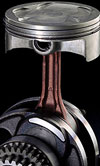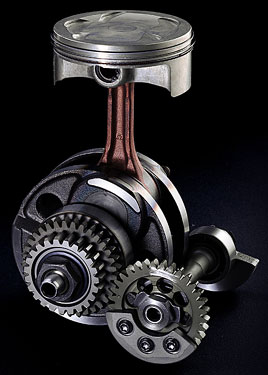Oil-shedding coatings
 There is wide agreement among racing engine manufacturers and builders that the source of much friction in the racing engine comes from the crankcase. These losses are not entirely due to the amount of lubricant in the crankcase, as I can attest from personal experience. But there can certainly be gains made in reducing frictional losses by minimising the amount of oil in the crankcase and better control of the oil that's there.
There is wide agreement among racing engine manufacturers and builders that the source of much friction in the racing engine comes from the crankcase. These losses are not entirely due to the amount of lubricant in the crankcase, as I can attest from personal experience. But there can certainly be gains made in reducing frictional losses by minimising the amount of oil in the crankcase and better control of the oil that's there.
In wet-sump engines the control of oil has traditionally been looked after by devices such as gauzes, scraper plates and windage trays and, if we needed further proof that racing engines improve road engines, many modern roadcar engines incorporate such devices to minimise friction. We can therefore say these devices are effective.
But there have also been other 'tricks' used to lessen the effects of friction, and one of these is to use oil-shedding coatings. These have been around in one form or another for a long time. Many years ago, they came in the form of polymer coatings which I have seen liberally applied to the insides of some racing engines. Now, there are specific oil-shedding coatings (also referred to as oleophobic coatings) that are applied to the internals of the engine, specifically crankcases, crankshafts and con rods, although there are certainly other applications where we might find a real gain.
If we are to ignore the adverse frictional effect of splash lubrication due to a crank skimming through a reservoir of oil, where else might we find frictional losses due to oil? The answer lies in the effect of oil shearing in confined spaces as high-speed surfaces sweep past. If we imagine oil trapped in a gap between two rotating plates - for example, the thrust faces on the crankshaft - there is a certain amount of force needed to shear the oil, and this is proportional to the viscosity of the oil and the area of oil being sheared, and inversely proportional to the gap between the surfaces.

So, from this knowledge, we can easily work out where our losses due to oil shear are going to come from, namely parts of the engine where there are small gaps between components with high relative speeds. The crankshaft is the focus of most of our attention - the crank counterweights sweep past the stationary crankcase walls within a few millimetres, and past the con rods, also in close proximity. In designing an engine we can try to provide greater clearance in order to lessen the shearing rate, but for fixed designs we are limited to our attempts to keep oil away from these sensitive areas.
Oil-shedding coatings are a way of doing this, and the results seem impressive. I recently spoke to Jack McInnis from Dart Machinery, a company providing a coating service to the motorsport industry. I asked McInnis what sort of gains could be expected due to oil-shedding coatings and his answer was, "We often see increases of nine to 15 horsepower above 5000 rpm when both the crank and rods are coated in a performance engine."
These results alone suggest that the coatings may be worthy of investigation, especially in an engine where the oil flow rate in the crankcase is high.
Fig. 1 - Crankshafts and con rods are among those components considered most suitable for the use of oil-shedding coatings
Written by Wayne Ward